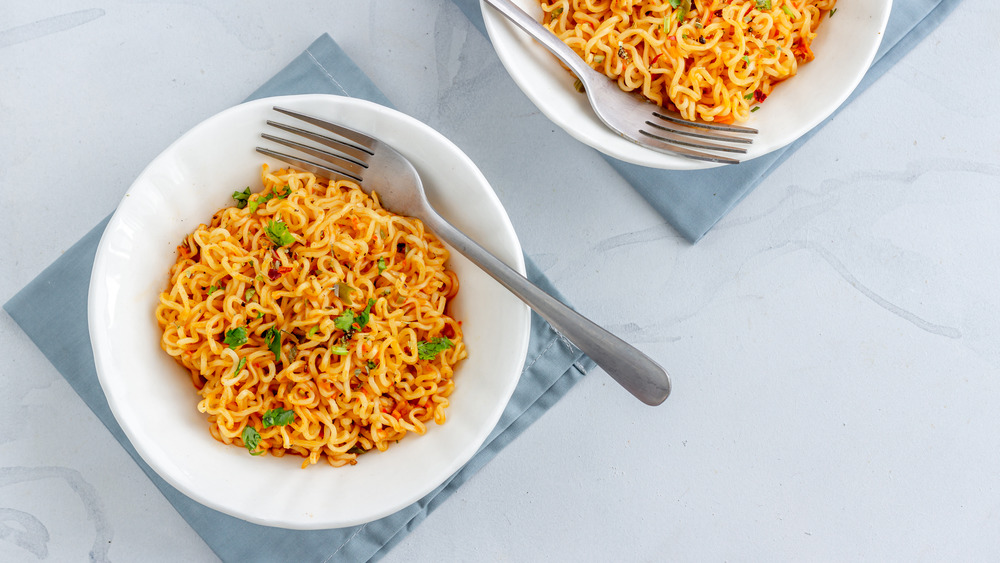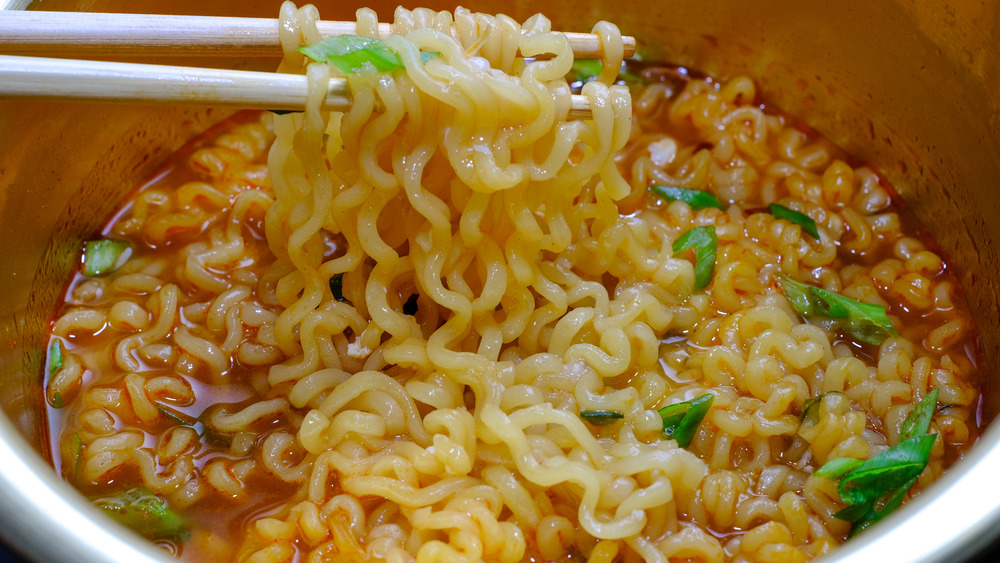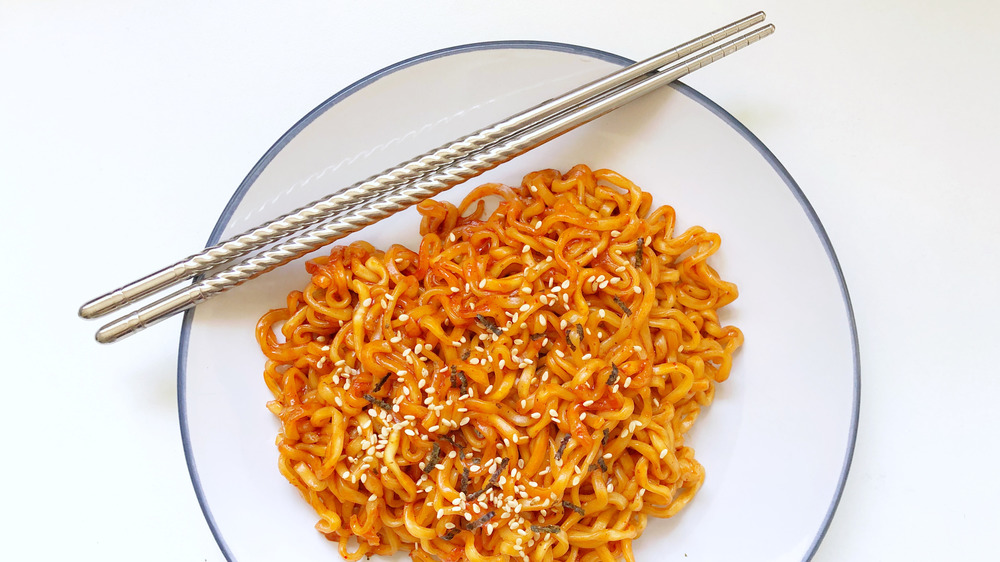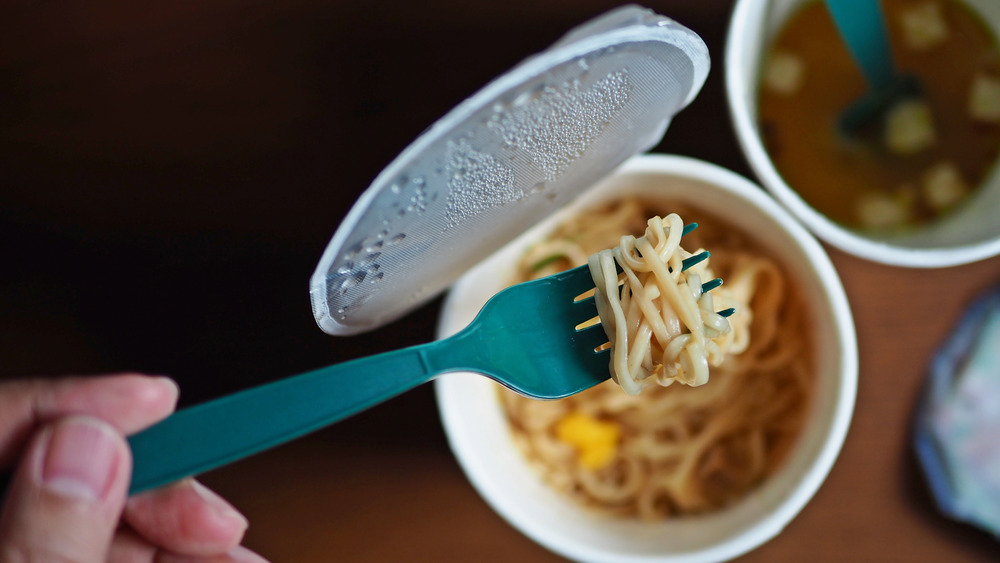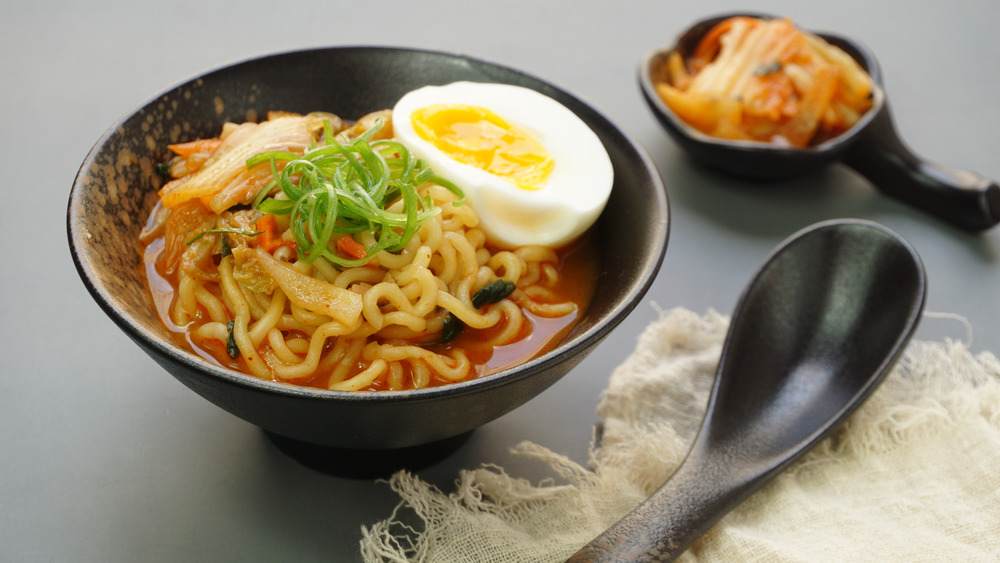Here's What You Need To Know About Ramyeon
Have you ever heard of ramyeon? Nope, not ramen — ramyeon. If you haven't, it's time to get to know this Korean comfort food staple. While the word "ramen" might make some of us think of the hearty noodle soups served in upscale Japanese restaurants and others think of late-night college study sesh Cup Noodles — indeed, ramen refers to both of these things — ramyeon, in Korea, specifically refers to instant noodles, according to Korean cooking expert and YouTube sensation Emily Kim, aka Maangchi.
In recent years, ramyeon's popularity has exploded, with manufacturers of popular brands such as Nongshim (per Business Korea) and Samyang (per The Korea Herald) enjoying record-breaking sales both within Korea and across the world. Particularly within its home country, ramyeon is a veritable sensation, with each South Korean eating an average of 76 packages of ramyeon per year (via Statista). So let's take a look at these wildly popular noodles, shall we?
Ramyeon: some background
Samyang, Korea's first ramyeon brand, was founded in 1963 as a response to the difficult post-Korean War period when food staples such as rice and grains were still scarce in the recovering agrarian economy (via Samyang Foods). Samyang's new offering was an accessible and affordable option for Koreans, many of whom struggled with hunger. A couple of decades later, in 1986, a competitor, Shin Ramyun, joined the scene (per Nongshim USA). According to the noodles' official website, since that year, more than 22 million bags of Shin Ramyun have been sold — more than 100 times the distance from the Earth to the moon, when placed end to end. Ottogi Ramen rounds out the big three of Korean ramyeon, offering wacky flavors that range from cheddar cheese to spaghetti.
Since its debut in Korea in 1963, ramyeon's popularity, both domestically and internationally, has skyrocketed. In 2020, Nongshim announced that U.S. sales of its product had reached an all-time high of more than $160 million in the first half of that year, a 30 percent increase from 2019 (via Business Korea). In the same year, Samyang Foods reported similar growth, with global sales up 30 percent from 2019 and an incredible 100 percent growth of sales in the U.S. market (via The Korea Herald).
2020: the year of ramyeon
Ramyeon has enjoyed immense popularity since its debut, but 2020, in particular, was a banner year for the instant noodles. Several factors came together to make 2020 the year of Korean ramyeon. Most obviously, as noted by both the Business Korea and Korea Herald articles, was the COVID-19 pandemic. In the early days of the outbreak, when people were panic-buying pantry staples at stores, instant noodles made an obvious companion to the rolls of toilet paper and jumbo bottles of water in shoppers' carts. A less cynical take, offered by Korean-Canadian journalist Vivian Song on The Takeout, was a search for comfort in uncertain times.
"In a year of restaurant closures, lockdowns, and quarantine, we sought comfort food and convenience," she writes. "Instant Korean ramyeon, Americans would discover, is a cheap and cheerful five-minute flavor bomb of a meal with many different varieties to choose from."
The impact of the New York Times and a box-office hit
Also contributing to the juggernaut of ramyeon sales in 2020 was a June New York Times article ranking Nongshim's Shin Black Noodle Soup ramyeon the best out of 11 varieties of instant noodles. "It has a winning combination of a complex, spicy broth, substantial dehydrated vegetables, and toothsome noodles," the article's author, Anna Perling, notes. "I couldn't stop eating these."
The movies also had something to do with the rise of ramyeon in 2020. A year earlier, Korean cult favorite director Bong Joon-ho released Parasite, a dark comedy/thriller that (per Variety) became a surprise hit all over the world. In one of the movie's pivotal scenes, the wealthy Park family at the center of the film's plot instructs their housekeeper to prepare a pot of "ram-don," a mashup of ramen and udon that is basically just two of Nongshim's ramyeon flavors, Chapagetti and Neoguri, cooked together (via The Takeout). Classed up with the uber-expensive Hanwoo beef (via Kim'C Market) befitting the family's social class, the dish as seen in Parasite piqued viewers' interest in Korean instant noodles and inspired a wave of articles in food media; Nongshim even released a Parasite-inspired "Chapaguri" instant noodle in response.
Ramyeon at home: where to begin?
With several high-profile brands of ramyeon offering dozens of flavors each, it's hard to know where to start if you want to try one. Considering the popularity of the New York Times-recommended Shin Black Noodle Soup, made by Nongshim, that's one suggestion; the article's author recommends, specifically, the Spicy Pot-au-feu flavor. Nongshim's official website sure makes the soup sound appealing, describing it like this:
"The most noticeable thing about Shin Ramyun Black is the thick, meaty broth enhanced with garlic and vegetables to ensure that our consumers get the nutrients they need. In addition, red pepper and green onion are added to give Shin Ramyun Black the famous 'kick' of Shin Ramyun."
Elsewhere, on The Takeout, Korean-Canadian journalist Vivian Song takes a shine to Samyang's Buldak Ramen, stir-fried noodles with chicken in a hot sauce with sesame seeds and grilled seaweed. Just be sure you like spicy: Song notes that the noodles' sauce reaches a scalding 4,400 on the Scoville Heat Unit scale.
But what does Maangchi think?
No examination of Korean food would be complete without a weigh-in from the doyenne of Korean food herself, Maangchi. On her website, Maangchi offers a version of quick, classed up ramyeon — not quite as classed up as the Parks' version, but upgraded nonetheless — featuring green onions, kimchi, and a poached egg.
To make it, Maangchi simply boils instant noodles with their seasoning packet for one minute, cracks an egg directly into the pot to poach it, removes the pot from the heat and adds the ramyeon's packet of freeze-dried veggies, plus fresh green onions, prepared kimchi, and hot, cooked rice.
"The first time I tried it, I couldn't believe how tasty it was, how simple it was to make," she writes.
That's it: we're adding (six packages of) ramyeon to this week's grocery list. And we'll be pulling up Parasite on demand, too.
